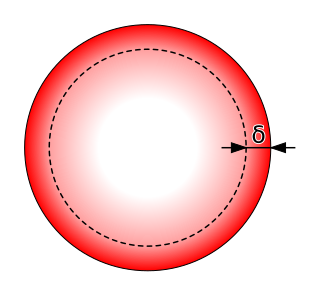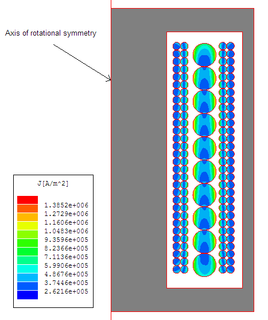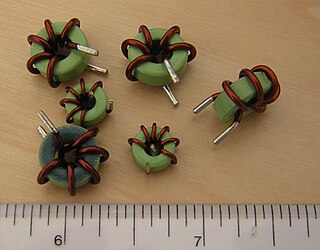
An electromagnetic coil is an electrical conductor such as a wire in the shape of a coil, spiral or helix. Electromagnetic coils are used in electrical engineering, in applications where electric currents interact with magnetic fields, in devices such as electric motors, generators, inductors, electromagnets, transformers, and sensor coils. Either an electric current is passed through the wire of the coil to generate a magnetic field, or conversely an external time-varying magnetic field through the interior of the coil generates an EMF (voltage) in the conductor.

An inductor, also called a coil, choke, or reactor, is a passive two-terminal electrical component that stores energy in a magnetic field when electric current flows through it. An inductor typically consists of an insulated wire wound into a coil around a core.
Multiprotocol Label Switching (MPLS) is a routing technique in telecommunications networks that directs data from one node to the next based on short path labels rather than long network addresses, thus avoiding complex lookups in a routing table and speeding traffic flows. The labels identify virtual links (paths) between distant nodes rather than endpoints. MPLS can encapsulate packets of various network protocols, hence the "multiprotocol" reference on its name. MPLS supports a range of access technologies, including T1/E1, ATM, Frame Relay, and DSL.

An electromagnet is a type of magnet in which the magnetic field is produced by an electric current. Electromagnets usually consist of wire wound into a coil. A current through the wire creates a magnetic field which is concentrated in the hole in the center of the coil. The magnetic field disappears when the current is turned off. The wire turns are often wound around a magnetic core made from a ferromagnetic or ferrimagnetic material such as iron; the magnetic core concentrates the magnetic flux and makes a more powerful magnet.

In electromagnetism and electronics, inductance describes the tendency of an electrical conductor, such as coil, to oppose a change in the electric current through it. The change in current induces a reverse electromotive force (voltage). When an electric current flows through a conductor, it creates a magnetic field around that conductor. A changing current, in turn, creates a changing magnetic field, the surface integral of which is known as magnetic flux. From Faraday's law of induction, any change in magnetic flux through a circuit induces an electromotive force (voltage) across that circuit, a phenomenon known as electromagnetic induction. Inductance, , is defined as the ratio between this induced voltage, , and the rate of change of the current in the circuit.

Skin effect is the tendency of an alternating electric current (AC) to become distributed within a conductor such that the current density is largest near the surface of the conductor, and decreases with greater depths in the conductor. The electric current flows mainly at the "skin" of the conductor, between the outer surface and a level called the skin depth. The skin effect causes the effective resistance of the conductor to increase at higher frequencies where the skin depth is smaller, thus reducing the effective cross-section of the conductor. The skin effect is due to opposing eddy currents induced by the changing magnetic field resulting from the alternating current. At 60 Hz in copper, the skin depth is about 8.5 mm. At high frequencies the skin depth becomes much smaller. Increased AC resistance due to the skin effect can be mitigated by using specially woven litz wire. Because the interior of a large conductor carries so little of the current, tubular conductors such as pipe can be used to save weight and cost.

A balun is an electrical device that converts between a balanced signal and an unbalanced signal. A balun can take many forms and may include devices that also transform impedances but need not do so. Transformer baluns can also be used to connect lines of differing impedance. Sometimes, in the case of transformer baluns, they use magnetic coupling but need not do so. Common-mode chokes are also used as baluns and work by eliminating, rather than ignoring, common mode signals.

A flyback transformer (FBT), also called a line output transformer (LOPT), is a special type of electrical transformer. It was initially designed to generate high voltage sawtooth signals at a relatively high frequency. In modern applications, it is used extensively in switched-mode power supplies for both low (3 V) and high voltage supplies.

A CCFL inverter is an electrical inverter that supplies alternating current power to a cold cathode fluorescent lamp (CCFL). CCFLs are often used as inexpensive light units in electrical devices that are powered by direct current sources such as batteries. CCFL inverters are small, have switchover efficiency over 80%, and offer adjustable output of light. They are widely used for backlights for LCDs, or for rear lighting in advertising signs.
Leakage inductance derives from the electrical property of an imperfectly-coupled transformer whereby each winding behaves as a self-inductance in series with the winding's respective ohmic resistance constant. These four winding constants also interact with the transformer's mutual inductance. The winding leakage inductance is due to leakage flux not linking with all turns of each imperfectly-coupled winding.

Seen in some magnetic materials, saturation is the state reached when an increase in applied external magnetic field H cannot increase the magnetization of the material further, so the total magnetic flux density B more or less levels off. Saturation is a characteristic of ferromagnetic and ferrimagnetic materials, such as iron, nickel, cobalt and their alloys.
The Parametric transformer is a particular type of transformer. It transfers the power from primary to secondary windings not by mutual inductance coupling but by a variation of a parameter in its magnetic circuit. First described by Wanlass, et al., 1968.

A blocking oscillator is a simple configuration of discrete electronic components which can produce a free-running signal, requiring only a resistor, a transformer, and one amplifying element. The name is derived from the fact that the transistor is cut-off or "blocked" for most of the duty-cycle, producing periodic pulses. The non-sinusoidal output is not suitable for use as a radio-frequency local oscillator, but it can serve as a timing generator, to power lights, LEDs, Elwire, or small neon indicators. The simple tones are also sufficient for applications such as alarms or a Morse code practice device. Some cameras use a blocking oscillator to strobe the flash prior to a shot to reduce the red-eye effect.

A variety of types of electrical transformer are made for different purposes. Despite their design differences, the various types employ the same basic principle as discovered in 1831 by Michael Faraday, and share several key functional parts.

In a conductor carrying alternating current, if currents are flowing through one or more other nearby conductors, such as within a closely wound coil of wire, the distribution of current within the first conductor will be constrained to smaller regions. The resulting current crowding is termed the proximity effect. This crowding gives an increase in the effective resistance of the circuit, which increases with frequency.

Toroidal inductors and transformers are inductors and transformers which use magnetic cores with a toroidal shape. They are passive electronic components, consisting of a circular ring or donut shaped magnetic core of ferromagnetic material such as laminated iron, iron powder, or ferrite, around which wire is wound.
A Molypermalloy Powder (MPP) core is a toroidal magnetic core comprised from the powder of multiple alloys. It is distributed with air gaps to help condense its magnetic field to minimize core losses. Its composition is made from approximately 79% nickel, 17% iron, and 4% molybdenum.
Mean Length Turn, sometimes Mean Length per Turn is the mean length of winding turn in a coil, usually referred to by the initials MLT. The dimensions of a coil former or bobbin define the MLT of a full wound coil. In some cases the coil is not made of a single wire with multiple turns, and a coil former is not always necessary, but may be constructed in a stack of printed circuit layers. The MLT is an important measure in the design of inductors, transformers and other wound components.














